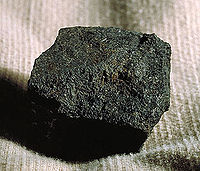
Photo from wikipedia
Abstract Semi-coke and residual carbon are potential to serve as reducing agents for NO reduction in deep-staged co-combustion, while the impacts of flue gas components, O2 and CO, on NO… Click to show full abstract
Abstract Semi-coke and residual carbon are potential to serve as reducing agents for NO reduction in deep-staged co-combustion, while the impacts of flue gas components, O2 and CO, on NO heterogeneous reduction by semi-coke and residual carbon from practical industrial production have yet to be fully understood. The ash originated from different ashing methods, traditional high-temperature ashing method and low-temperature plasma ashing method, has different component distributions, which is also likely to generate important effects on NO reduction. However, the roles of components within various ash samples in NO-CO homogeneous reduction are still unclear. In this paper, the reactivities of various semi-cokes and residual carbon were experimentally studied for NO reduction using a lab-scale fixed-bed reactor. The experimental results indicate that the reactivities of semi-cokes and residual carbon towards NO reduction increase significantly when the temperature is beyond 700 °C, with more than 80% of NO being reduced at >850 °C. The addition of O2 tends to decrease NO conversion owing to the competition between NO and O2 for reacting with semi-coke. Carbon monoxide contributes to NO reduction significantly because it can not only reduce NO through the homogeneous reaction between CO and NO, but also lower the activation energy of the heterogeneous NO-char reaction. The interaction effects on NO conversion and apparent activation energy vary with the reaction temperature and CO concentration. In addition, ash samples from semi-coke are more efficient catalysts for NO homogeneous reduction than those of residual carbon.
Journal Title: Fuel
Year Published: 2021
Link to full text (if available)
Share on Social Media: Sign Up to like & get
recommendations!